Diabetes Dictionary: A - E
A
B
C
D
E
F
G
H
I
J
K
L
M
N
O
P
R
S
T
U
V
W
X
The Diabetes Dictionary
A
acanthosis (uh-kan-THO-sis) nigricans (NIH-grih-kans):
a skin condition characterized by darkened skin patches; common in people whose body is not responding correctly to the insulin that they make in their pancreas (insulin resistance). This skin condition is also seen in people who have pre-diabetes or type 2 diabetes.
acarbose (AK-er-bose): an oral medicine used to treat type 2 diabetes. It blocks the enzymes that digest starches in food. The result is a slower and lower rise in blood glucose throughout the day, especially right after meals. Belongs to the class of medicines called alpha-glucosidase inhibitors. (Brand name: Precose.)
ACE inhibitor: an oral medicine that lowers blood pressure; ACE stands for angiotensin (an-gee-oh-TEN-sin) converting enzyme. For people with diabetes, especially those who have protein (albumin) in the urine, it also helps slow down kidney damage.
acesulfame (a-see-SUL-fame) potassium (puh-TAS-ee-um): a dietary sweetener with no calories and no nutritional value. Also known as acesulfame-K. (Brand name: Sunett.)
acetohexamide (a-see-toh-HEX-uh-myde): an oral medicine used to treat type 2 diabetes. It lowers blood glucose by helping the pancreas make more insulin and by helping the body better use the insulin it makes. Belongs to the class of medicines called sulfonylureas. (Brand name: Dymelor.)
Actos: see pioglitazone.
acute: describes something that happens suddenly and for a short time. Opposite of chronic.
adhesive capsulitis (cap-soo-LITE-is): a condition of the shoulder associated with diabetes that results in pain and loss of the ability to move the shoulder in all directions.
adult-onset diabetes: former term for type 2 diabetes.
AGEs (A-G-EEZ): stands for advanced glycosylation (gly-KOH-sih-LAY-shun) endproducts. AGEs are produced in the body when glucose links with protein. They play a role in damaging blood vessels, which can lead to diabetes complications.
albuminuria (al-BYOO-mih-NOO-ree-uh): a condition in which the urine has more than normal amounts of a protein called albumin. Albuminuria may be a sign of nephropathy (kidney disease).
alpha (AL-fa) cell: a type of cell in the pancreas. Alpha cells make and release a hormone called glucagon. The body sends a signal to the alpha cells to make glucagon when blood glucose falls too low. Then glucagon reaches the liver where it tells it to release glucose into the blood
for energy.
alpha-glucosidase (AL-fa-gloo-KOH-sih-days) inhibitor: a class of oral medicine for type 2 diabetes that blocks enzymes that digest starches in food. The result is a slower and lower rise in blood glucose throughout the day, especially right after meals. (Generic names: acarbose and miglitol.)
Amaryl: see glimepiride.
amylin (AM-ih-lin): a hormone formed by beta cells in the pancreas. Amylin regulates the timing of glucose release into the bloodstream after eating by slowing the emptying of the stomach.
amyotrophy (a-my-AH-truh-fee): a type of neuropathy resulting in pain, weakness, and/or wasting in the muscles.
anemia (uh-NEE-mee-uh): a condition in which the number of red blood cells is less than normal, resulting in less oxygen being carried to the body's cells.
angiopathy (an-gee-AH-puh-thee): any disease of the blood vessels (veins, arteries, capillaries) or lymphatic vessels.
antibodies (AN-ti-bod-eez): proteins made by the body to protect itself from "foreign" substances such as bacteria or viruses. People get type 1 diabetes when their bodies make antibodies that destroy the body's own insulin-making beta cells.
A1C: a test that measures a person's average blood glucose level over the past 2 to 3 months. Hemoglobin (HEE-mo-glo-bin) is the part of a red blood cell that carries oxygen to the cells and sometimes joins with the glucose in the bloodstream. Also called hemoglobin A1C or glycosylated (gly-KOH-sih-lay-ted) hemoglobin, the test shows the amount of glucose that sticks to the red blood cell, which is proportional to the amount of glucose in the blood.
ARB: an oral medicine that lowers blood pressure; ARB stands for angiotensin (an-gee-oh-TEN-sin) receptor blocker.
arteriosclerosis (ar-TEER-ee-oh-skluh-RO-sis):
hardening of the arteries.
artery: a large blood vessel that carries blood with oxygen from the heart to all parts of the body.
aspart (ASS-part) insulin: a rapid-acting insulin. On average, aspart insulin starts to lower blood glucose within 10 to 20 minutes after injection. It has its strongest effect 1 to 3 hours after injection but keeps working for 3 to 5 hours after injection.
aspartame (ASS-per-tame): a dietary sweetener with almost no calories and no nutritional value. (Brand names: Equal, NutraSweet.)
atherosclerosis (ATH-uh-row-skluh-RO-sis): clogging, narrowing, and hardening of the body's large arteries and medium-sized blood vessels. Atherosclerosis can lead to stroke, heart attack, eye problems, and kidney problems.
autoimmune (AW-toh-ih-MYOON) disease: disorder of the body's immune system in which the immune system mistakenly attacks and destroys body tissue that it believes to be foreign.
autonomic (aw-toh-NOM-ik) neuropathy (ne-ROP-uh-thee): a type of neuropathy affecting the lungs, heart, stomach, intestines, bladder, or genitals.
Avandia:
see rosiglitazone.
[Top]
B
background retinopathy (REH-tih-NOP-uh-thee):
a type of damage to the retina of the eye marked by bleeding, fluid accumulation, and abnormal dilation of the blood vessels. Background retinopathy is an early stage of diabetic retinopathy. Also called simple or nonproliferative (non-pro-LIF-er-uh-tiv) retinopathy.
basal rate:
a steady trickle of low levels of longer-acting insulin, such as that used in insulin pumps.
beta cell:
a cell that makes insulin. Beta cells are located in the islets of the pancreas.
biguanide (by-GWAH-nide):
a class of oral medicine used to treat type 2 diabetes that lowers blood glucose by reducing the amount of glucose produced by the liver and by helping the body respond better to insulin. (Generic name: metformin.)
blood glucose:
the main sugar found in the blood and the body's main source of energy. Also called blood sugar.
blood glucose level:
the amount of glucose in a given amount of blood. It is noted in milligrams in a deciliter, or mg/dL.
blood glucose meter:
a small, portable machine used by people with diabetes to check their blood glucose levels. After pricking the skin with a lancet, one places a drop of blood on a test strip in the machine. The meter (or monitor) soon displays the blood glucose level as a number on the meter's digital display.
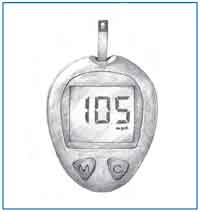
Blood glucose meter
blood glucose monitoring:
checking blood glucose level on a regular basis in order to manage diabetes. A blood glucose meter (or blood glucose test strips that change color when touched by a blood sample) is needed for frequent blood glucose monitoring.
blood pressure:
the force of blood exerted on the inside walls of blood vessels. Blood pressure is expressed as a ratio (example: 120/80, read as "120 over 80"). The first number is the systolic (sis-TAH-lik) pressure, or the pressure when the heart pushes blood out into the arteries. The second number is the diastolic (DY-uh-STAH-lik) pressure, or the pressure when the heart rests.
blood sugar:
see blood glucose.
blood sugar level:
see blood glucose level.
blood urea (yoo-REE-uh) nitrogen (NY-truh-jen) (BUN):
a waste product in the blood from the breakdown of protein. The kidneys filter blood to remove urea. As kidney function decreases, the BUN levels increase.
blood vessels:
tubes that carry blood to and from all parts of the body. The three main types of blood vessels are arteries, veins, and capillaries.
BMI:
see body mass index.
body mass index (BMI):
a measure used to evaluate body weight relative to a person's height. BMI is used to find out if a person is underweight, normal weight, overweight, or obese.
| To find BMI: Multiply body weight in pounds by 703. Divide that number by height in inches. Divide that number by height in inches again. Find the resulting numberin the chart below. |
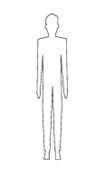 |
 |
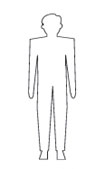 |
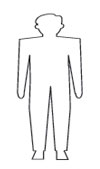 |
| Below 18.5 is underweight. |
18.5–24.9 is normal. |
25.0–29.9 is overweight. |
30.0 and above is obese. |
|
bolus (BOH-lus):
an extra amount of insulin taken to cover an expected rise in blood glucose, often related to a meal or snack.
borderline diabetes:
a former term for type 2 diabetes or impaired glucose tolerance.
brittle diabetes:
a term used when a person's blood glucose level moves often from low to high and from high to low.
BUN:
see blood urea nitrogen.
bunion (BUN-yun):
a bulge on the first joint of the big toe, caused by the swelling of a fluid sac under the skin. This spot can become red, sore, and infected.
[Top]
C
callus:
a small area of skin, usually on the foot, that has become thick and hard from rubbing or pressure.
calorie:
a unit representing the energy provided by food. Carbohydrate, protein, fat, and alcohol provide calories in the diet. Carbohydrate and protein have 4 calories per gram, fat has 9 calories per gram, and alcohol has 7 calories per gram.
capillary (KAP-ih-lair-ee):
the smallest of the body's blood vessels. Oxygen and glucose pass through capillary walls and enter the cells. Waste products such as carbon dioxide pass back from the cells into the blood through capillaries.
capsaicin (kap-SAY-ih-sin):
an ingredient in hot peppers that can be found in ointment form for use on the skin to relieve pain from diabetic neuropathy.
carbohydrate (kar-boh-HY-drate):
one of the three main nutrients in food. Foods that provide carbohydrate are starches, vegetables, fruits, dairy products, and sugars.
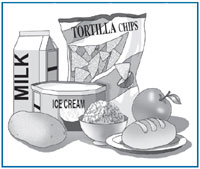
Sources of carbohydrate
carbohydrate counting:
a method of meal planning for people with diabetes based on counting the number of grams of carbohydrate in food.
cardiologist (kar-dee-AH-luh-jist):
a doctor who treats people who have heart problems.
cardiovascular (KAR-dee-oh-VASK-yoo-ler) disease:
disease of the heart and blood vessels (arteries, veins, and capillaries).
cataract (KA-ter-act):
clouding of the lens of the eye.
CDE: see certified diabetes educator.
cerebrovascular (seh-REE-broh-VASK-yoo-ler) disease:
damage to blood vessels in the brain. Vessels can burst and bleed or become clogged with fatty deposits. When blood flow is interrupted, brain cells die or are damaged, resulting in a stroke.
certified diabetes educator (CDE):
a health care professional with expertise in diabetes education who has met eligibility requirements and successfully completed a certification exam.
See diabetes educator.
Charcot's (shar-KOHZ) foot:
a condition in which the joints and soft tissue in the foot are destroyed; it results from damage to the nerves.
cheiroarthropathy (KY-roh-ar-THRAHP-uh-thee):
see limited joint mobility.
cheiropathy (ky-RAH-puh-thee): see limited joint mobility.
chlorpropamide (klor-PROH-pah-mide):
an oral medicine used to treat type 2 diabetes. It lowers blood glucose levels by helping the pancreas make more insulin and by helping the body better use the insulin it makes. Belongs to the class of medicines called sulfonylureas. (Brand name: Diabinese.)
cholesterol (koh-LES-ter-all):
a type of fat produced by the liver and found in the blood; it is also found in some foods. Cholesterol is used by the body to make hormones and build cell walls.
chronic:
describes something that is long-lasting. Opposite of acute.
circulation:
the flow of blood through the body's blood vessels and heart.
coma:
a sleep-like state in which a person is not conscious. May be caused by hyperglycemia (high blood glucose) or hypoglycemia (low blood glucose) in people with diabetes.
combination oral medicines:
a pill that includes two or more different medicines. See Glucovance.
combination therapy:
the use of different medicines together (oral hypoglycemic agents or an oral hypoglycemic agent and insulin) to manage the blood glucose levels of people with type 2 diabetes.
complications:
harmful effects of diabetes such as damage to the eyes, heart, blood vessels, nervous system, teeth and gums, feet and skin, or kidneys. Studies show that keeping blood glucose, blood pressure, and low-density lipoprotein cholesterol levels close to normal can help prevent or delay these problems.
congenital (kun-JEN-ih-tul) defects: problems or conditions that are present at birth.
congestive heart failure:
loss of the heart's pumping power, which causes fluids to collect in the body, especially in the feet and lungs.
conventional therapy:
a term used in clinical trials where one group receives treatment for diabetes in which A1C and blood glucose levels are kept at levels based on current practice guidelines. However, the goal is not to keep blood glucose levels as close to normal as possible, as is done in intensive therapy. Conventional therapy includes use of medication, meal planning, and exercise, along with regular visits to health care providers.
coronary artery disease: see coronary heart disease.
coronary (KOR-uh-ner-ee) heart disease:
heart disease caused by narrowing of the arteries that supply blood to the heart. If the blood supply is cut off the result is a heart attack.
C-peptide (see-peptide):
"Connecting peptide," a substance the pancreas releases into the bloodstream in equal amounts to insulin. A test of C-peptide levels shows how much insulin the body is making.
creatinine (kree-AT-ih-nin):
a waste product from protein in the diet and from the muscles of the body. Creatinine is removed from the body by the kidneys; as kidney disease progresses, the level of creatinine in the blood increases.
[Top]
D
dawn phenomenon (feh-NAH-meh-nun):
the early-morning (4 a.m. to 8 a.m.) rise in blood glucose level.
DCCT:
see Diabetes Control and Complications Trial.
dehydration (dee-hy-DRAY-shun):
the loss of too much body fluid through frequent urinating, sweating, diarrhea, or vomiting.
dermopathy (dur-MAH-puh-thee):
disease of the skin.
desensitization (dee-sens-ih-tiz-A-shun):
a way to reduce or stop a response such as an allergic reaction to something. For example, if someone has an allergic reaction to something, the doctor gives the person a very small amount of the substance at first to increase one's tolerance. Over a period of time, larger doses are given until the person is taking the full dose. This is one way to help the body get used to the full dose and to prevent the allergic reaction.
dextrose (DECKS-trohss), also called glucose:
simple sugar found in blood that serves as the body's main source of energy.
DiaBeta:
see glyburide.
diabetes:
see diabetes mellitus.
Diabetes Control and Complications Trial (DCCT):
a study by the National Institute of Diabetes and Digestive and Kidney Diseases, conducted from 1983 to 1993 in people with type 1 diabetes. The study showed that intensive therapy compared to conventional therapy significantly helped prevent or delay diabetes complications. Intensive therapy included multiple daily insulin injections or the use of an insulin pump with multiple blood glucose readings each day. Complications followed in the study included diabetic retinopathy, neuropathy, and nephropathy.
diabetes educator:
a health care professional who teaches people who have diabetes how to manage their diabetes. Some diabetes educators are certified diabetes educators (CDEs). Diabetes educators are found in hospitals, physician offices, managed care organizations, home health care, and other settings.
diabetes insipidus (in-SIP-ih-dus):
a condition characterized by frequent and heavy urination, excessive thirst, and an overall feeling of weakness. This condition may be caused by a defect in the pituitary gland or in the kidney. In diabetes insipidus, blood glucose levels are normal.
diabetes mellitus (MELL-ih-tus):
a condition characterized by hyperglycemia resulting from the body's inability to use blood glucose for energy. In type 1 diabetes, the pancreas no longer makes insulin and therefore blood glucose cannot enter the cells to be used for energy. In type 2 diabetes, either the pancreas does not make enough insulin or the body is unable to use insulin correctly.
Diabetes Prevention Program (DPP):
a study by the National Institute of Diabetes and Digestive and Kidney Diseases conducted from 1998 to 2001 in people at high risk for type 2 diabetes. All study participants had impaired glucose tolerance, also called pre-diabetes, and were overweight. The study showed that people who lost 5 to 7 percent of their body weight through a low-fat, low-calorie diet and moderate exercise (usually walking for 30 minutes 5 days a week) reduced their risk of getting type 2 diabetes by 58 percent. Participants who received treatment with the oral diabetes drug metformin reduced their risk of getting type 2 diabetes by 31 percent.
diabetic diarrhea (dy-uh-REE-uh):
loose stools, fecal incontinence, or both that result from an overgrowth of bacteria in the small intestine and diabetic neuropathy in the intestines. This nerve damage can also result in constipation.
diabetic eye disease:
see diabetic retinopathy.
diabetic ketoacidosis (KEY-toe-ass-ih-DOH-sis) (DKA):
an emergency condition in which extremely high blood glucose levels, along with a severe lack of insulin, result in the breakdown of body fat for energy and an accumulation of ketones in the blood and urine. Signs of DKA are nausea and vomiting, stomach pain, fruity breath odor, and rapid breathing. Untreated DKA can lead to coma and death.
diabetic myelopathy (my-eh-LAH-puh-thee):
damage to the spinal cord found in some people with diabetes.
diabetic nephropathy: see nephropathy.
diabetic neuropathy:
see neuropathy.
diabetic retinopathy (REH-tih-NOP-uh-thee):
diabetic eye disease; damage to the small blood vessels in the retina. Loss of vision may result.
diabetogenic (DY-uh-beh-toh-JEN-ic):
causing diabetes. For example, some drugs cause blood glucose levels to rise, resulting in diabetes.
diabetologist (DY-uh-beh-TAH-luh-jist):
a doctor who specializes in treating people who have diabetes.
Diabinese:
see chlorpropamide.
diagnosis (DY-ug-NO-sis):
the determination of a disease from its signs and symptoms.
dialysis (dy-AL-ih-sis):
the process of cleaning wastes from the blood artificially. This job is normally done by the kidneys. If the kidneys fail, the blood must be cleaned artificially with special equipment. The two major forms of dialysis are hemodialysis and peritoneal dialysis.
- hemodialysis (HE-mo-dy-AL-ih-sis): the use of a machine to clean wastes from the blood after the kidneys have failed. The blood travels through tubes to a dialyzer (DY-uh-LY-zur), a machine that removes wastes and extra fluid. The cleaned blood then goes back into the body.

Hemodialysis
- peritoneal (PEH-rih-tuh-NEE-ul) dialysis: cleaning the blood by using the lining of the abdomen as a filter. A cleansing solution called dialysate (dy-AL-ih-sate) is infused from a bag into the abdomen. Fluids and wastes flow through the lining of the belly and remain "trapped" in the dialysate. The dialysate is then drained from the belly, removing the extra fluids and wastes from the body.
dietitian (DY-eh-TIH-shun):
a health care professional who advises people about meal planning, weight control, and diabetes management. A registered dietitian (RD) has more training.
dilated (DY-lay-ted) eye exam:
a test done by an eye care specialist in which the pupil (the black center) of the eye is temporarily enlarged with eyedrops to allow the specialist to see the inside of the eye more easily.

Dilated eye

Undilated eye
DKA: see diabetic ketoacidosis.
D-phenylalanine (dee-fen-nel-AL-ah-neen) derivative:
a class of oral medicine for type 2 diabetes that lowers blood glucose levels by helping the pancreas make more insulin right after meals. (Generic name: nateglinide.)
DPP:
see Diabetes Prevention Program.
Dupuytren's (doo-PWEE-trenz) contracture (kon-TRACK-chur):
a condition associated with diabetes in which the fingers and the palm of the hand thicken and shorten, causing the fingers to curve inward.
Dymelor:
see acetohexamide.
[Top]
E
edema (eh-DEE-muh):
swelling caused by excess fluid in the body.
electromyography (ee-LEK-troh-my-AH-gruh-fee) (EMG):
a test used to detect nerve function. It measures the electrical activity generated by muscles.
EMG:
see electromyography.
endocrine (EN-doh-krin) gland:
a group of specialized cells that release hormones into the blood. For example, the islets in the pancreas, which secrete insulin, are endocrine glands.
endocrinologist (EN-doh-krih-NAH-luh-jist):
a doctor who treats people who have endocrine gland problems such as diabetes.
end-stage renal disease (ESRD):
see kidney failure.
enzyme (EN-zime):
protein made by the body that brings about a chemical reaction, for example, the enzymes produced by the gut to aid digestion.
erectile dysfunction:
see impotence.
euglycemia (you-gly-SEEM-ee-uh):
a normal level of glucose in the blood.
exchange lists:
one of several approaches for diabetes meal planning. Foods are categorized into three groups based on their nutritional content. Lists provide the serving sizes for carbohydrates, meat and meat alternatives, and fats. These lists allow for substitution for different groups to keep the nutritional content fixed.
[Top]
Diabetes Dictionary Index
A
B
C
D
E
F
G
H
I
J
K
L
M
N
O
P
R
S
T
U
V
W
X
[Top]
|




